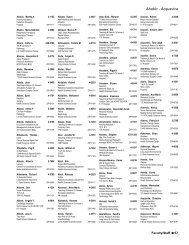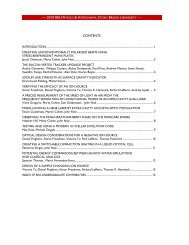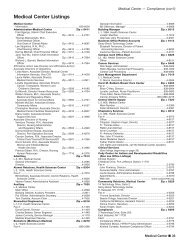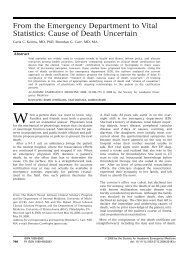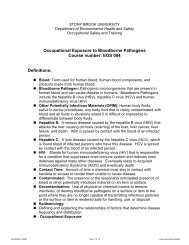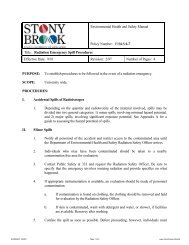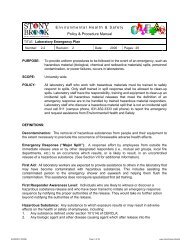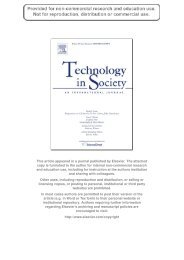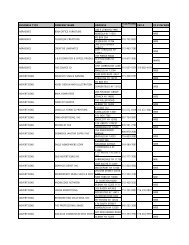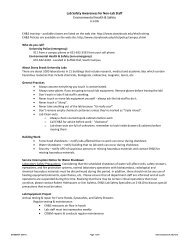A Gentle and Human Temper: Humility in Medicine - Stony Brook ...
A Gentle and Human Temper: Humility in Medicine - Stony Brook ...
A Gentle and Human Temper: Humility in Medicine - Stony Brook ...
You also want an ePaper? Increase the reach of your titles
YUMPU automatically turns print PDFs into web optimized ePapers that Google loves.
Access Provided by <strong>Stony</strong> <strong>Brook</strong> University (SUNY) at 05/02/11 7:44PM GMT
“A <strong>Gentle</strong> <strong>and</strong> <strong>Human</strong>e<br />
<strong>Temper</strong>”<br />
humility <strong>in</strong> medic<strong>in</strong>e<br />
Jack Coulehan<br />
ABSTRACT <strong>Humility</strong> is the medical virtue most difficult to underst<strong>and</strong> <strong>and</strong> practice.<br />
This is especially true <strong>in</strong> contemporary medic<strong>in</strong>e, which has developed a culture<br />
more characterized by arrogance <strong>and</strong> entitlement than by self-effacement <strong>and</strong> moderation.<br />
In such a culture, humility suggests weakness, <strong>in</strong>decisiveness, or even deception,<br />
as <strong>in</strong> false modesty. Nonetheless, an operational def<strong>in</strong>ition of medical humility <strong>in</strong>cludes<br />
four dist<strong>in</strong>ct but closely related personal characteristics that are central to good doctor<strong>in</strong>g:<br />
unpretentious openness, honest self-disclosure, avoidance of arrogance, <strong>and</strong><br />
modulation of self-<strong>in</strong>terest. <strong>Humility</strong>, like other virtues, is best taught by means of narrative<br />
<strong>and</strong> role model<strong>in</strong>g.We may rightly be proud of contemporary medical advances,<br />
while at the same time experienc<strong>in</strong>g gratitude <strong>and</strong> humility as healers.<br />
IN HIS STORY ENTITLED “Toenails,” the surgeon Richard Selzer (1982) warns<br />
readers that total immersion <strong>in</strong> medic<strong>in</strong>e is wrongheaded. Rather, to ensure<br />
their own health, doctors should discover other passions that permit them periodically<br />
to disconnect from medical practice. Selzer’s surgeon character devotes<br />
his Wednesday afternoons to the public library, where he jo<strong>in</strong>s “a subculture of<br />
elderly men <strong>and</strong> women who gather . . . to read or sleep beneath the world’s<br />
newspapers” (p. 69). Among these often eccentric personages is Neckerchief, an<br />
arthritic man <strong>in</strong> his 80s who suffers from severe foot pa<strong>in</strong>. His toenails, never<br />
Center for Medical <strong>Human</strong>ities, Compassionate Care, <strong>and</strong> Bioethics, Health Sciences Center, <strong>Stony</strong><br />
<strong>Brook</strong> University, <strong>Stony</strong> <strong>Brook</strong>, NY 11794-8335.<br />
E-mail: jcoulehan@notes.cc.sunysb.edu.<br />
Perspectives <strong>in</strong> Biology <strong>and</strong> Medic<strong>in</strong>e, volume 54, number 2 (spr<strong>in</strong>g 2011):206–16<br />
© 2011 by The Johns Hopk<strong>in</strong>s University Press<br />
206
“A <strong>Gentle</strong> <strong>and</strong> <strong>Human</strong>e <strong>Temper</strong>”<br />
trimmed because of his <strong>in</strong>ability to reach them, have grown so long that they<br />
curve beneath his toes <strong>and</strong> dig <strong>in</strong>to the sk<strong>in</strong> when he walks.When the surgeon<br />
learns of Neckerchief ’s problem, he rushes back to his office, picks up a pair of<br />
heavy-duty nail clippers, <strong>and</strong> returns to the library where, with Neckerchief<br />
perched on a toilet <strong>in</strong> the men’s room, he trims the man’s nails. This results <strong>in</strong><br />
immediate pa<strong>in</strong> relief. Subsequently, the surgeon br<strong>in</strong>gs his nail clipper to the<br />
library every Wednesday <strong>and</strong> often performs the same service for other homeless<br />
eccentrics, like Stovepipe <strong>and</strong> Mrs. Fr<strong>in</strong>ges.<br />
When I present this touch<strong>in</strong>g story to medical students, they respond immediately<br />
to its humor <strong>and</strong> compassion.They consider the surgeon a role model of<br />
unpretentiousness.They enjoy the way he punctures the balloon of medical arrogance.<br />
But even though we discuss the story <strong>in</strong> the context of professional virtue,<br />
they’re very reluctant to apply the word humility to his character or behavior.<br />
This is not surpris<strong>in</strong>g. Nowadays, humility is hardly a valued ideal.The words<br />
“good physician” call up an image of confidence, technical skill, <strong>and</strong> assertiveness,<br />
a cluster of characteristics that seems <strong>in</strong>consistent with humility. Medic<strong>in</strong>e’s<br />
popular image features drama, angst, <strong>and</strong> celebrity, rather than prudence. Although<br />
compassionate care rema<strong>in</strong>s an avowed goal of medic<strong>in</strong>e, the virtues associated<br />
with compassion (e.g., prudence <strong>and</strong> humility) are less popular. In<br />
today’s medical culture, humility appears weak, wishy-washy, counterproductive,<br />
or even deceptive (as <strong>in</strong> the case of “false modesty”). Moreover, patients themselves<br />
are likely to question the competence of doctors who too quickly acknowledge<br />
their own limitations.<br />
Medical humility was already a hard sell <strong>in</strong> 1906, when William Osler tried to<br />
whip up enthusiasm for humility <strong>in</strong> a lecture to University of M<strong>in</strong>nesota medical<br />
students, with these prescient words: “In these days of aggressive self-assertion,<br />
when the stress of competition is so keen <strong>and</strong> the desire to make the most<br />
of oneself so universal, it may seem a little old-fashioned to preach the necessity<br />
of humility, but I <strong>in</strong>sist . . . that a due humility should take the place of honor on<br />
your list [of virtues]” (p. 121). I suspect that Osler’s students, like those of today,<br />
were not especially attracted to humility, although <strong>in</strong> their culture the word virtue<br />
would not have seemed as strange <strong>and</strong> affected as it does today. Few students <strong>in</strong><br />
2011 conceive of their education <strong>in</strong> terms of character formation at all, let alone<br />
see humility as part of it. Does anyone still believe that virtue is its own reward?<br />
When Osler said that humility should take “the place of honor” among medical<br />
virtues, what did he mean? What, specifically, does humility mean when applied<br />
to medical practice? St<strong>and</strong>ard def<strong>in</strong>itions provide little help. The Oxford<br />
English Dictionary def<strong>in</strong>es humility as “the quality of be<strong>in</strong>g humble” or “an act of<br />
self-abasement,” while the adjective humble, <strong>in</strong> turn, means “hav<strong>in</strong>g or show<strong>in</strong>g a<br />
low op<strong>in</strong>ion of one’s own importance.”Wikipedia offers the follow<strong>in</strong>g: humility<br />
is “the quality of be<strong>in</strong>g modest, reverential, even politely submissive, <strong>and</strong> never<br />
be<strong>in</strong>g arrogant, contemptuous, rude.” Such def<strong>in</strong>itions are neither endear<strong>in</strong>g, nor<br />
very helpful. In this article I want to rehabilitate humility by explor<strong>in</strong>g what it<br />
spr<strong>in</strong>g 2011 • volume 54, number 2 207
Jack Coulehan<br />
might mean <strong>in</strong> the context of medical professionalism—<strong>in</strong> other words, to operationalize<br />
the concept.<br />
I must beg<strong>in</strong> by acknowledg<strong>in</strong>g that a given attitude or behavior pattern may<br />
be molded by more than a s<strong>in</strong>gle virtue.Thus, my students are correct <strong>in</strong> say<strong>in</strong>g<br />
that the surgeon <strong>in</strong> “Toenails” exemplifies compassion. My contention is that his<br />
behavior also demonstrates humility. One can be humble without be<strong>in</strong>g compassionate<br />
<strong>and</strong> vice versa, but <strong>in</strong> many contexts these <strong>and</strong> other virtues overlap.<br />
My goal here is to <strong>in</strong>vestigate the observable characteristics that constitute the<br />
“meat” of humility as a virtue <strong>in</strong> medic<strong>in</strong>e. If professionalism is a core competency<br />
<strong>in</strong> medical education, <strong>and</strong> if demonstrat<strong>in</strong>g medical virtue is an essential<br />
part of professionalism, <strong>and</strong> if humility is an acknowledged medical virtue, then<br />
what might it look like <strong>in</strong> practice? To that end I consider four dist<strong>in</strong>ct but<br />
closely related personal attributes: (1) unpretentious openness, (2) avoidance of<br />
arrogance, (3) honest self-disclosure, <strong>and</strong> (4) modulation of self-<strong>in</strong>terest.<br />
Unpretentious Openness<br />
The first <strong>and</strong> most obvious feature of humility as a professional virtue is acceptance<br />
of one’s limitations or, as Thomas Aqu<strong>in</strong>as (2007) put it, hav<strong>in</strong>g “knowledge<br />
of one’s own deficiency” (p. 277). Realistic self-assessment allows for “openness<br />
to new ideas, contradictory <strong>in</strong>formation, <strong>and</strong> advice” (Tangney 2000). In an essay<br />
published <strong>in</strong> Mayo Cl<strong>in</strong>ic Proceed<strong>in</strong>gs, Li (1999) characterized the humble physician<br />
as be<strong>in</strong>g “able to appreciate the mysteries of disease <strong>and</strong> the marvels of heal<strong>in</strong>g”<br />
(p. 529). <strong>Humility</strong> acknowledges ambiguities, mysteries, <strong>and</strong> surprises. It’s an<br />
<strong>in</strong>terior response to the <strong>in</strong>sight that medic<strong>in</strong>e is “totally awesome,” as my children<br />
used to say.This is what I mean by unpretentious openness.<br />
Last summer the nurs<strong>in</strong>g staff on an oncology unit at our hospital was dumbfounded<br />
when a newly m<strong>in</strong>ted <strong>in</strong>tern sat down with the husb<strong>and</strong> of a term<strong>in</strong>al<br />
cancer patient. He had stepped <strong>in</strong>to the room <strong>and</strong> asked the husb<strong>and</strong> if he would<br />
like a cup of coffee, <strong>in</strong>dicat<strong>in</strong>g that he was on his way to get a cup himself.After<br />
br<strong>in</strong>g<strong>in</strong>g the coffees, the <strong>in</strong>tern sat quietly for 45 m<strong>in</strong>utes, listen<strong>in</strong>g to the man<br />
talk about his wife <strong>and</strong> their life together.The <strong>in</strong>tern sat mostly <strong>in</strong> silence, communicat<strong>in</strong>g<br />
his <strong>in</strong>terest nonverbally.This episode was so astound<strong>in</strong>g to the nurses<br />
because they considered the behavior out of character for a physician, especially<br />
for a harried house officer. If truth be told, such a conversation would also have<br />
been out of character for a nurse on that unit, because the nurses’ schedules are<br />
so rigidly regimented.<br />
Why is such an <strong>in</strong>cident unusual? Surely, most physicians-<strong>in</strong>-tra<strong>in</strong><strong>in</strong>g experience<br />
empathy <strong>and</strong> compassion for their term<strong>in</strong>al cancer patients. It is perfectly<br />
true that the <strong>in</strong>tense dem<strong>and</strong>s of their jobs may not normally permit them to<br />
spend substantial time with <strong>in</strong>dividual patients <strong>and</strong> their families.Yet how many<br />
residents are responsive to the possibility of do<strong>in</strong>g so, if <strong>and</strong> when an appropriate<br />
occasion arises? I consider this vignette as suggest<strong>in</strong>g humility because it illustrates<br />
208<br />
Perspectives <strong>in</strong> Biology <strong>and</strong> Medic<strong>in</strong>e
“A <strong>Gentle</strong> <strong>and</strong> <strong>Human</strong>e <strong>Temper</strong>”<br />
the <strong>in</strong>tern’s unpretentious openness to an opportunity, whether planned or unplanned.<br />
He could have f<strong>in</strong>ished his chart<strong>in</strong>g, had lunch, or taken a break to read<br />
the latest specialty journal, but <strong>in</strong>stead he chose to sit quietly with his patient <strong>and</strong><br />
her husb<strong>and</strong>.<br />
To function with<strong>in</strong> your own capabilities, you first have to be aware of what<br />
they are, to assess your personal strengths <strong>and</strong> weaknesses realistically, as well as<br />
your medical knowledge <strong>and</strong> abilities. Thus, the start<strong>in</strong>g po<strong>in</strong>t for humility is<br />
self-awareness, an attribute that today’s fast-paced medical tra<strong>in</strong><strong>in</strong>g <strong>and</strong> our culture<br />
<strong>in</strong> general do not foster. In fact, <strong>in</strong>trospection is highly disvalued <strong>in</strong> the hidden<br />
curriculum that permeates medical education (Coulehan 2005; Coulehan<br />
<strong>and</strong> Williams 2001; Hafferty <strong>and</strong> Franks 1994; Hunnert 1996). At best, selfawareness,<br />
like the art of medic<strong>in</strong>e, bedside manner, cl<strong>in</strong>ical judgment, <strong>and</strong> professional<br />
virtue, tends to be damned with fa<strong>in</strong>t praise: a desirable attribute that<br />
ought to develop as the young physician ga<strong>in</strong>s experience <strong>and</strong> maturity, but not<br />
a topic that should be addressed <strong>in</strong> the curriculum. While medical educators<br />
question whether such qualities can be taught, they assume that young doctors<br />
will learn them as a result of cl<strong>in</strong>ical experience. The concept that teach<strong>in</strong>g is<br />
restricted to processes that transmit facts or convey technical skills is prevalent <strong>in</strong><br />
medic<strong>in</strong>e. This is strange, because medic<strong>in</strong>e traditionally relied on good role<br />
model<strong>in</strong>g as a prime source of cl<strong>in</strong>ical <strong>and</strong> moral education. Role model<strong>in</strong>g is<br />
teach<strong>in</strong>g, <strong>and</strong> tra<strong>in</strong>ees learn to be good doctors from their role models.<br />
As part of a course called Foundations of Medical Practice, I facilitate a group<br />
of 10 or 12 first-year medical students <strong>in</strong> a sequence of sessions on self-awareness,<br />
personal growth, <strong>and</strong> professional values. (Coulehan 2010). Each group <strong>in</strong>cludes<br />
one or more students who are <strong>in</strong>itially skeptical about the objectives of<br />
this sequence. “The discussions are <strong>in</strong>terest<strong>in</strong>g,” they’ll expla<strong>in</strong>, “but right now<br />
we’re under so much academic pressure that we can’t enjoy them. We have<br />
anatomy <strong>and</strong> physiology exams to study for. It’s not like we learn anyth<strong>in</strong>g <strong>in</strong><br />
small group.After all, these issues have no right or wrong answers.” Such students<br />
usually offer unhelpful suggestions—for example, the course should be optional<br />
or offered later <strong>in</strong> their curriculum.They believe that the meat <strong>and</strong> potatoes of<br />
education consists of learn<strong>in</strong>g facts <strong>and</strong> technical skills; engagement with <strong>in</strong>terpersonal,<br />
moral, <strong>and</strong> emotional issues is dessert, nice but not necessary. Fortunately,<br />
most of the skeptics are co-opted <strong>in</strong>to the group process by their peers <strong>and</strong>,<br />
by the end of the course, are will<strong>in</strong>g to buy <strong>in</strong>to medical education as, at least <strong>in</strong><br />
part, a process of character formation <strong>and</strong> self-discovery.<br />
Avoidance of Arrogance<br />
A second feature of humility as a professional virtue derives naturally from the<br />
first: avoidance or suppression of arrogance. Many believe that arrogance is more<br />
pervasive <strong>in</strong> <strong>and</strong> characteristic of today’s medical persona than openness or modesty.<br />
A number of factors <strong>in</strong> ourselves, our profession, <strong>and</strong> society contribute to<br />
spr<strong>in</strong>g 2011 • volume 54, number 2 209
Jack Coulehan<br />
the belief that physicians are entitled to special h<strong>and</strong>l<strong>in</strong>g. Not long ago a Spanish<br />
translator <strong>in</strong> my hospital was devastated when a physician pushed her aside as he<br />
rushed <strong>in</strong>to a non-English-speak<strong>in</strong>g patient’s room.“I don’t have time to spend<br />
talk<strong>in</strong>g,” he growled.“I need to do this procedure right now.”And he did, while<br />
the frightened patient had no idea what was happen<strong>in</strong>g (Coulehan 2010). The<br />
process of <strong>in</strong>formed consent was a sham. Unfortunately, such rude <strong>and</strong> assertive<br />
behavior is not uncommon. And <strong>in</strong> addition to its damag<strong>in</strong>g effect on patients,<br />
arrogant behavior by doctors may be responsible for low hospital morale, high<br />
levels of stress, <strong>and</strong> high staff turnover (Berger 2002;Tark<strong>in</strong> 2008).<br />
John Gregory (1772) wrote: “Experience demonstrates that a gentle <strong>and</strong><br />
humane temper, so far from be<strong>in</strong>g <strong>in</strong>consistent with vigor of m<strong>in</strong>d, is its usual<br />
attendant; <strong>and</strong> that rough <strong>and</strong> bluster<strong>in</strong>g manners generally accompany a weak<br />
underst<strong>and</strong><strong>in</strong>g <strong>and</strong> a mean soul” (p. 182). However, many aspects of medical education<br />
foster a strong sense of entitlement that encourages “rough <strong>and</strong> bluster<strong>in</strong>g<br />
manners.” Students overcome <strong>in</strong>numerable <strong>in</strong>tellectual, emotional, social, <strong>and</strong><br />
economic hurdles <strong>in</strong> order to become physicians. In a culture that glorifies<br />
<strong>in</strong>stant gratification, they delay personal <strong>and</strong> f<strong>in</strong>ancial reward for many years <strong>in</strong><br />
order to achieve their objectives.They also accumulate massive debts from student<br />
loans.They reach professional maturity <strong>in</strong> a hospital culture that disvalues<br />
<strong>in</strong>trospection <strong>and</strong> vulnerability (Coulehan 2010). Entitlement is also promoted<br />
by a “hidden curriculum,” which teaches young physicians that self-<strong>in</strong>terest is<br />
the real name of the game (Coulehan 2005; Coulehan <strong>and</strong> Williams 2001; Hafferty<br />
<strong>and</strong> Franks 1994; Hunnert 1996).The difficult process of becom<strong>in</strong>g a doctor,<br />
which once engendered <strong>in</strong>terdependence, collegiality, <strong>and</strong> shared values<br />
among physicians, tends now to be <strong>in</strong>terpreted more solipsistically, as a series of<br />
challenges to be met <strong>and</strong> overcome on one’s own. One’s ultimate success is a<br />
solitary accomplishment.<br />
The House of God, Samuel Shem’s (2003) ironic saga of <strong>in</strong>ternship, is almost an<br />
urtext for this culture of entitlement. Shem’s story purports to tell how dysfunctional<br />
medical tra<strong>in</strong><strong>in</strong>g squeezes the natural humanity <strong>and</strong> compassion out<br />
of young doctors. In fact, however, a close read<strong>in</strong>g reveals that most of its characters<br />
come off as poster boys or girls for self-justify<strong>in</strong>g exceptionalism (Coulehan<br />
2008). Noth<strong>in</strong>g <strong>in</strong> the book suggests that these doctors ever connected with,<br />
or advocated for, their patients to beg<strong>in</strong> with.Yes, they may have been victims of<br />
unfeel<strong>in</strong>g senior physicians, but they were, at the same time, victimizers of their<br />
patients <strong>and</strong> the hospital staff.<br />
As Patrick Duff (2004) observed:“<strong>Humility</strong> should be at the top of the list of<br />
desirable professional attributes. . . . [However,] medical students <strong>and</strong> physicians<br />
are very accomplished <strong>and</strong> highly successful <strong>in</strong>dividuals.At times, their susta<strong>in</strong>ed<br />
pattern of success can lead to an <strong>in</strong>appropriate sense of entitlement <strong>and</strong> arrogance.<br />
From the perspective of patients <strong>and</strong> coworkers, noth<strong>in</strong>g is more immediately<br />
recognizable, more unsettl<strong>in</strong>g, <strong>and</strong> more offensive than hubris” (p. 1362).<br />
I’m not sure that hubris is precisely the right word here, s<strong>in</strong>ce it suggests the pres-<br />
210<br />
Perspectives <strong>in</strong> Biology <strong>and</strong> Medic<strong>in</strong>e
“A <strong>Gentle</strong> <strong>and</strong> <strong>Human</strong>e <strong>Temper</strong>”<br />
ence of an unavoidable fatal flaw. Physician arrogance is a flaw all right, but it is<br />
avoidable <strong>and</strong> usually isn’t fatal—except sometimes for patients.<br />
Honest Self-Disclosure<br />
A third feature associated with humility is honesty, especially about mistakes. In<br />
his Lectures on the Duties <strong>and</strong> Qualifications of a Physician (1772), the great Scottish<br />
physician John Gregory wrote: “I may reckon among the moral duties <strong>in</strong>cumbent<br />
on a physician that c<strong>and</strong>or, which makes him open to conviction, <strong>and</strong> ready<br />
to acknowledge <strong>and</strong> rectify his mistakes. . . .True knowledge <strong>and</strong> clear discernment<br />
. . . are <strong>in</strong>consistent with self-conceit” (p. 189).The duty to acknowledge<br />
medical error, at least to colleagues, is not controversial <strong>in</strong> theory, but <strong>in</strong> practice<br />
physicians tend to restrict or compartmentalize the concept of truthfulness.They<br />
blame American litigiousness for their reluctance to be truthful, although, historically,<br />
physician truthfulness about prognosis <strong>and</strong> error has usually been considered<br />
harmful to the patient <strong>and</strong>, therefore, not ethically warranted (Lazare<br />
2004; Oken 1961). In other words, physicians made a virtue of manipulat<strong>in</strong>g the<br />
truth before malpractice considerations reared their ugly head.<br />
Just how c<strong>and</strong>id should the doctor be? Is it sufficient to present a “softened”<br />
story, or to withhold some of the gory details? Moreover, is disclosure sufficient,<br />
or should physicians apologize for their mistakes? In his memoir Heal<strong>in</strong>g the<br />
Wounds (1985), David Hilfiker describes his years as a family physician <strong>in</strong> rural<br />
M<strong>in</strong>nesota. He tells the story of a woman whose un<strong>in</strong>tended abortion resulted<br />
from his failure to obta<strong>in</strong> a pelvic sonogram that was clearly <strong>in</strong>dicated. His patient<br />
experienced symptoms <strong>and</strong> signs of pregnancy, but repeated pregnancy tests<br />
were negative. Rather than send<strong>in</strong>g her to another town for a sonogram, Hilfiker<br />
diagnosed a missed abortion with reta<strong>in</strong>ed fetus, based on the cl<strong>in</strong>ical f<strong>in</strong>d<strong>in</strong>gs<br />
<strong>and</strong> negative tests.While do<strong>in</strong>g the D & C, he discovered that the fetus had been<br />
alive before the procedure. “Dur<strong>in</strong>g the days, <strong>and</strong> weeks, <strong>and</strong> months after I<br />
aborted Barb’s baby,” he writes,“my guilt <strong>and</strong> anger grew. . . .There was no way<br />
I could justify what I had done” (p. 380). Hilfiker apologized for his mistake to<br />
the patient <strong>and</strong> her husb<strong>and</strong>, but this didn’t dim<strong>in</strong>ish his own anguish:“I decided<br />
that it was my responsibility to deal with my guilt alone” (p. 380).<br />
Hilfiker subsequently shared this guilt with thous<strong>and</strong>s of readers. He later<br />
moved to Wash<strong>in</strong>gton, DC, <strong>and</strong> practiced <strong>in</strong> an <strong>in</strong>ner-city health center, an experience<br />
he recounts <strong>in</strong> Not All of Us Are Sa<strong>in</strong>ts (1994). Hilfiker’s confessional approach,<br />
as he struggles to justify his <strong>and</strong> his family’s privileged status <strong>in</strong> the midst<br />
of a dysfunctional <strong>and</strong> poverty-stricken community, is a mov<strong>in</strong>g example of<br />
humility. Later still, <strong>in</strong> Urban Injustice: How Ghettos Happen (2003), Hilfiker takes<br />
a step beyond personal reflection to social <strong>and</strong> economic criticism. His narratives<br />
allow us to explore the rugged terra<strong>in</strong> of honest acknowledgment <strong>and</strong> apology.<br />
Interest<strong>in</strong>gly, these stories, while engag<strong>in</strong>g, tend to make the reader uncomfortable.<br />
Such stark honesty about one’s doubts, values, limitations, <strong>and</strong> mistakes is<br />
spr<strong>in</strong>g 2011 • volume 54, number 2 211
Jack Coulehan<br />
difficult to confront.We would rather manage disclosure of mistakes by modulat<strong>in</strong>g<br />
the responsibility (everyone has bad days, my hours are too long, other<br />
people’s mistakes led to my mistake, etc.).We would rather accept our privileged<br />
status <strong>in</strong> life without delv<strong>in</strong>g too deeply <strong>in</strong>to the heart of fairness. However, for<br />
Hilfiker confession is an essential component <strong>in</strong> the process of personal heal<strong>in</strong>g.<br />
And on a more day-to-day level, it is clear that a simple apology results <strong>in</strong> measurable<br />
benefits for both patient <strong>and</strong> doctor: “An effective apology is one of the<br />
most profound heal<strong>in</strong>g processes between <strong>in</strong>dividuals, groups, or nations” (Lazare<br />
2006, p. 1403).<br />
Modulation of Self-Interest<br />
A f<strong>in</strong>al feature of humility is the ability to ma<strong>in</strong>ta<strong>in</strong> <strong>in</strong>ner balance <strong>and</strong> to modulate<br />
self-<strong>in</strong>terest. Pellegr<strong>in</strong>o <strong>and</strong> Thomasma (1993) approach humility, which<br />
they call “self-effacement,” by focus<strong>in</strong>g on the relative roles of altruism <strong>and</strong> egoism<br />
<strong>in</strong> medic<strong>in</strong>e. Accord<strong>in</strong>g to Jonsen (1992), the tension between self-<strong>in</strong>terest<br />
<strong>and</strong> altruism create a paradox at the core of medic<strong>in</strong>e. Self-effacement is the virtue<br />
that modulates or suppresses the tendency for one’s self-<strong>in</strong>terest to <strong>in</strong>terfere<br />
with serv<strong>in</strong>g the patient’s <strong>in</strong>terests—<strong>in</strong> other words, humility facilitates altruism.<br />
Pellegr<strong>in</strong>o <strong>and</strong> Thomasma argue that self-effacement functions like yeast, allow<strong>in</strong>g<br />
other virtues to “rise” <strong>and</strong> express themselves. The good doctor embodies<br />
compassion, respect, <strong>and</strong> fidelity precisely because she is sufficiently reflective<br />
<strong>and</strong> motivated to down-regulate her personal <strong>in</strong>terests (e.g., convenience, peer<br />
approval, pleasure, f<strong>in</strong>ancial ga<strong>in</strong>, power, or prestige) when it is <strong>in</strong> her patients’<br />
best <strong>in</strong>terests to do so.<br />
This notion of discover<strong>in</strong>g a morally appropriate balance of <strong>in</strong>terests reflects<br />
Aristotle’s concept of the Golden Mean. It acknowledges the moral claims of<br />
both parties. Obviously, physicians have duties to themselves <strong>and</strong> their families, as<br />
well as to patients.The idea of total self-effacement evokes the myth of a practitioner<br />
who devotes his entire life <strong>and</strong> energy to help<strong>in</strong>g others, <strong>in</strong> essence, empty<strong>in</strong>g<br />
himself out. S<strong>in</strong>ce this is an unatta<strong>in</strong>able ideal for most doctors, it presents<br />
an easy target for critics who believe that serious consideration of virtue <strong>in</strong> medic<strong>in</strong>e<br />
is unrealistic, nostalgic, <strong>and</strong> self-delud<strong>in</strong>g. However, humility framed as a<br />
search for the Golden Mean focuses on the practical task of maximiz<strong>in</strong>g altruistic<br />
behavior, while at the same time acknowledg<strong>in</strong>g one’s personal needs <strong>and</strong> limits.<br />
This k<strong>in</strong>d of balanc<strong>in</strong>g or reflective equilibrium harks back to self-awareness.<br />
Good physicians have a duty to put the <strong>in</strong>terests of their patients ahead of self<strong>in</strong>terests,<br />
<strong>in</strong>sofar as a reflective acceptance of their personal limitations will allow.<br />
212<br />
Perspectives <strong>in</strong> Biology <strong>and</strong> Medic<strong>in</strong>e
Virtue as Narrative<br />
“A <strong>Gentle</strong> <strong>and</strong> <strong>Human</strong>e <strong>Temper</strong>”<br />
The virtue tradition holds that there are deeply held values <strong>and</strong> qualities <strong>in</strong>ternal<br />
to the goals of the profession, a commitment to moral behavior grounded <strong>in</strong><br />
“that which I hold most sacred” (to quote a contemporary version of the Hippocratic<br />
Oath). In practice, this traditional view is a k<strong>in</strong>d of meta-narrative or<br />
narrative ideal that has developed over 2,500 years as a summation of, <strong>and</strong> reflection<br />
upon, stories of actual <strong>and</strong> fictional physicians practic<strong>in</strong>g <strong>in</strong> different times<br />
<strong>and</strong> cultures.While the values <strong>and</strong> qualities can be def<strong>in</strong>ed abstractly, such def<strong>in</strong>itions<br />
are not compell<strong>in</strong>g; they don’t show us the way. It is easy enough to say<br />
(as does the Oxford English Dictionary) that compassion is “participation <strong>in</strong> another’s<br />
suffer<strong>in</strong>g; fellow feel<strong>in</strong>g, sympathy.” However, only a concrete example<br />
will help open our eyes to the personal mean<strong>in</strong>g of compassion.When a lawyer<br />
asked Jesus of Nazareth what “to love your neighbor” means, Jesus responded<br />
with the story of the Good Samaritan, rather than with a general statement, like<br />
“you should do what you can to help everyone who needs help.”<br />
In a sense, the names of medical virtues—words like <strong>in</strong>tegrity, compassion, altruism,<br />
courage, fidelity, <strong>and</strong> humility—represent post-hoc categories by which we<br />
<strong>in</strong>terpret hundreds <strong>and</strong> thous<strong>and</strong>s of heal<strong>in</strong>g narratives: myths, parables, narrative<br />
poems, epics, sacred writ<strong>in</strong>gs, <strong>and</strong> especially the lives of real doctors confront<strong>in</strong>g<br />
conflict <strong>and</strong> qu<strong>and</strong>ary <strong>in</strong> their professional lives. By allow<strong>in</strong>g these stories to <strong>in</strong>fluence<br />
our character formation, we learn what virtue means. Thus, the narratives<br />
medical tra<strong>in</strong>ees create <strong>in</strong> response to the behavior of role model physicianteachers<br />
are the most important component, build<strong>in</strong>g upon the more general<br />
narratives of virtue <strong>in</strong>ternalized dur<strong>in</strong>g childhood <strong>and</strong> adolescence. Likewise,<br />
stories of doctors like Albert Schweitzer, David Hilfiker, Paul Farmer, William<br />
Osler, Cicely Saunders, Cather<strong>in</strong>e Caldicott, Perri Klass, Danielle Ofri, <strong>and</strong><br />
Thomas Starzl teach us more about virtuous traits than we could ever learn by<br />
def<strong>in</strong>itions, rules, guidel<strong>in</strong>es, or algorithms for virtuous behavior. The same is<br />
true of fictional physicians, as <strong>in</strong> stories by Anton Chekhov, Mikhail Bulgakov,<br />
William Carlos Williams, Richard Selzer, Susan Mates, <strong>and</strong> others (Monroe <strong>and</strong><br />
Coulehan 2002).<br />
Under the aegis of the new professionalism, explicit attention to virtue has<br />
made a dramatic comeback <strong>in</strong> medical education (Coulehan 2005; Hafferty <strong>and</strong><br />
Lev<strong>in</strong>son 2008; K<strong>in</strong>ghorn, McEvoy, <strong>and</strong> Balboni 2007). In my school, like many<br />
others, the competency-based curriculum requires that students demonstrate, <strong>and</strong><br />
be evaluated on, behavioral manifestations of <strong>in</strong>tegrity, altruism, respect, <strong>and</strong><br />
compassion. Whether or not the current educational focus on professionalism<br />
achieves its ultimate objectives, the trend reveals a conscious movement toward<br />
reengagement with traditional values. However, the question rema<strong>in</strong>s:“Does the<br />
emperor of the new professionalism have any clothes?” (K<strong>in</strong>ghorn, McEvoy, <strong>and</strong><br />
Balboni 2007). I believe for the clothes to be real, medical tra<strong>in</strong>ees must <strong>in</strong>ternalize<br />
professionalism as “a bundle of contemporary narratives, either observed<br />
spr<strong>in</strong>g 2011 • volume 54, number 2 213
Jack Coulehan<br />
directly through role model physicians <strong>and</strong> other health professionals, or <strong>in</strong>directly<br />
through stories <strong>and</strong> film. In other words, to learn professionalism is to enter<br />
<strong>in</strong>to a certa<strong>in</strong> k<strong>in</strong>d of narrative <strong>and</strong> make it one’s own” (Coulehan 2005, p. 897).<br />
I’ve suggested the term “narrative-based professionalism” to refer to this tradition,<br />
<strong>in</strong> contrast to “rule-based professionalism,” which emphasizes objectives,<br />
competencies, <strong>and</strong> measurable behaviors that dissect <strong>and</strong> reconstruct the concept<br />
of professionalism, but do not focus on its narrative ethos (Coulehan 2005).<br />
Students will remember a story like Selzer’s “Toenails” long after they’ve forgotten<br />
the list of medical virtues given <strong>in</strong> Pellegr<strong>in</strong>o <strong>and</strong> Thomasma’s book.<br />
Moreover, when Selzer’s character comments,“I never go to the library on Wednesday<br />
afternoon without my nail clippers <strong>in</strong> my briefcase” (p. 69), it means<br />
someth<strong>in</strong>g to them as aspir<strong>in</strong>g physicians.They can relate to his simple, unpretentious<br />
attitude, even if they violently resist call<strong>in</strong>g it “humility.”As Selzer’s surgeon<br />
comments further,“You just never know” (p. 69).<br />
Conclusion<br />
In this essay I’ve highlighted the virtue of humility because it is perhaps the most<br />
difficult for contemporary physicians to grapple with. What does it mean <strong>in</strong><br />
practice? The <strong>in</strong>junction “Be compassionate” evokes a reasonably clear image of<br />
what is required. However, the <strong>in</strong>junction “Be humble” sends a mixed message.<br />
Our narratives about compassion are fully positive, but narratives about humility<br />
leave us with questions. Doesn’t humility compromise medical effectiveness?<br />
Shouldn’t we make a virtue of reduc<strong>in</strong>g our limitations, rather than acknowledg<strong>in</strong>g<br />
them? How can humility be tracked or measured?<br />
My hypothesis is that physicians who cultivate unpretentious openness, honest<br />
self-disclosure, <strong>and</strong> modulation of self-<strong>in</strong>terest, <strong>and</strong> who avoid arrogance, have<br />
demonstrated humility. I recognize the substantial overlap that exists among<br />
these categories, but they are not identical <strong>and</strong> consider<strong>in</strong>g them separately has<br />
heuristic value.<br />
These days hospitals compete relentlessly for market share, trumpet<strong>in</strong>g their<br />
lead<strong>in</strong>g-edge facilities <strong>and</strong> outst<strong>and</strong><strong>in</strong>g medical staffs. Their advertisements<br />
scream: our doctors are the best <strong>in</strong> the nation! We have the world’s f<strong>in</strong>est cancer<br />
specialists! We’re ranked #1 <strong>in</strong> heart surgery! Some <strong>in</strong>stitutions also <strong>in</strong>clude a<br />
softer pitch by trumpet<strong>in</strong>g their staff ’s compassion, fidelity, <strong>and</strong> personalized care.<br />
However, one professional virtue plays absolutely no role <strong>in</strong> today’s medical market<br />
place: humility. Imag<strong>in</strong>e, if you will, a full-page spread <strong>in</strong> the NewYork Times<br />
headl<strong>in</strong>ed with these words: OUR DOCTORS RANK AMONG THE MOST<br />
HUMBLE IN THE UNITED STATES. WE ADMIT OUR MISTAKES. WE<br />
READILY ACKNOWLEDGE OUR LIMITATIONS!<br />
How many patients would such a pitch attract? Not a s<strong>in</strong>gle one, I suspect,<br />
except perhaps the occasional ethics professor. In fact, most readers would burst<br />
214<br />
Perspectives <strong>in</strong> Biology <strong>and</strong> Medic<strong>in</strong>e
“A <strong>Gentle</strong> <strong>and</strong> <strong>Human</strong>e <strong>Temper</strong>”<br />
<strong>in</strong>to laughter before switch<strong>in</strong>g their allegiance to the competition. And no wonder.<br />
We rightfully seek excellence, <strong>in</strong>tegrity, <strong>and</strong> compassion <strong>in</strong> our physicians.<br />
We want good results. We want to feel cared for. In the marketplace humility<br />
seems counterproductive.<br />
One th<strong>in</strong>g is certa<strong>in</strong>: to morally <strong>in</strong>vigorate our profession for the 21st century,<br />
the movement toward explicit emphasis on behavioral competencies—<strong>in</strong>terpersonal<br />
competence, cultural competence, narrative competence, <strong>and</strong> so forth—<br />
will need to be supplemented by emphasis as well on develop<strong>in</strong>g self-awareness,<br />
underst<strong>and</strong><strong>in</strong>g the limitations of competence, <strong>and</strong> allow<strong>in</strong>g due consideration for<br />
human vulnerability. In the new professionalism, unpretentious openness, honest<br />
self-disclosure, avoidance of arrogance, <strong>and</strong> modulation of self-<strong>in</strong>terest must be<br />
<strong>in</strong>cluded as <strong>in</strong>tegral parts of the picture. And, taken together, they constitute<br />
humility.<br />
References<br />
Aqu<strong>in</strong>as,T. 2007. Summa theologica, vol. 3, part 2, trans. English Dom<strong>in</strong>ican Fathers. Charleston,<br />
SC: BiblioBazaar.<br />
Berger, A. S. 2002. Arrogance among physicians. Acad Med 77:145–47.<br />
Coulehan, J. 2005. Today’s professionalism: Engag<strong>in</strong>g the m<strong>in</strong>d, but not the heart. Acad<br />
Med 80:892–98.<br />
Coulehan, J. 2008. Imag<strong>in</strong><strong>in</strong>g the house of God. In Return to the house of God: Medical resident<br />
education, 1978–2008, ed. M. Kohn <strong>and</strong> C. Donley, 106–16. Kent, OH: Kent State<br />
Univ. Press.<br />
Coulehan, J. 2010. On humility. Ann Intern Med 153:200–201.<br />
Coulehan, J., <strong>and</strong> P. C.Williams. 2001.Vanquish<strong>in</strong>g virtue:The impact of medical education.<br />
Acad Med 76:598–605.<br />
Duff, P. 2004. Teach<strong>in</strong>g <strong>and</strong> assess<strong>in</strong>g professionalism <strong>in</strong> medic<strong>in</strong>e. Obstet Gynecol 104:<br />
1362–66.<br />
Gregory, J. 1772. Lectures on the duties <strong>and</strong> qualifications of a physician. In John Gregory’s writ<strong>in</strong>gs<br />
on medical ethics <strong>and</strong> philosophy of medic<strong>in</strong>e, ed. L. B. McCullough, 161–245. Dordrecht:<br />
Kluwer Academic, 1998.<br />
Hafferty, F. W., <strong>and</strong> R. Franks. 1994. The hidden curriculum, ethics teach<strong>in</strong>g, <strong>and</strong> the<br />
structure of medical education. Acad Med 69:861–71.<br />
Hafferty, F. W., <strong>and</strong> D. Lev<strong>in</strong>son. 2008. Mov<strong>in</strong>g beyond nostalgia <strong>and</strong> motives: Toward a<br />
complexity science view of medical professionalism. Perspect Biol Med 51:599–616.<br />
Hilfiker, D. 1985. Heal<strong>in</strong>g the wounds. New York: Pantheon.<br />
Hilfiker, D. 1994. Not all of us are sa<strong>in</strong>ts. New York: Farrar, Straus & Giroux.<br />
Hilfiker, D. 2003. Urban <strong>in</strong>justice: How ghettos happen. New York: Farrar, Straus & Giroux.<br />
Hunnert, E. M. 1996. Characteristics of the <strong>in</strong>formal curriculum <strong>and</strong> tra<strong>in</strong>ee’s ethical<br />
choices. Acad Med 71:624–33.<br />
Jonsen, A. 1992. The new medic<strong>in</strong>e <strong>and</strong> the old ethics. Cambridge: Harvard Univ. Press.<br />
K<strong>in</strong>ghorn, W. A., M. D. McEvoy, <strong>and</strong> M. A. Balboni. 2007. Professionalism <strong>in</strong> modern<br />
medic<strong>in</strong>e: Does the emperor have any clothes? Acad Med 82:40–45.<br />
spr<strong>in</strong>g 2011 • volume 54, number 2 215
Jack Coulehan<br />
Lazare, A. 2004. On apology. New York: Oxford Univ. Press.<br />
Lazare, A. 2006. Apology <strong>in</strong> medical practice: An emerg<strong>in</strong>g cl<strong>in</strong>ical skill. JAMA 296:<br />
1401–4.<br />
Li, J.T. C. 1999. <strong>Humility</strong> <strong>and</strong> the practice of medic<strong>in</strong>e. Mayo Cl<strong>in</strong> Proc 74:529–30.<br />
Monroe, W., <strong>and</strong> J. Coulehan. 2002. Literature <strong>and</strong> medic<strong>in</strong>e. In Fundamentals of cl<strong>in</strong>ical<br />
practice:A textbook on the patient, doctor, <strong>and</strong> society, 99–117. NewYork: Plenum Medical<br />
Books.<br />
Oken, D. 1961. What to tell cancer patients: A study of medical attitudes. JAMA 175:<br />
1120–28.<br />
Osler,W. 1906.Teacher <strong>and</strong> student. In Osler’s “A way of life” <strong>and</strong> other addresses, ed. S. H<strong>in</strong>ohara<br />
<strong>and</strong> H. Niki, 107–24. Durham: Duke Univ. Press, 2001.<br />
Pellegr<strong>in</strong>o, E. D., <strong>and</strong> D. C.Thomasma. 1993. The virtues <strong>in</strong> medical practice. NewYork: Oxford<br />
Univ. Press.<br />
Selzer, R. 1982 Toenails. In Letters to a young doctor, 64–69. New York. Simon <strong>and</strong> Schuster.<br />
Shem, S. 2003. The house of God. New York: Bantam Dell.<br />
Tangney, J. P. 2000. <strong>Humility</strong>:Theoretical perspectives, empirical f<strong>in</strong>d<strong>in</strong>gs, <strong>and</strong> directions<br />
for future research. J Soc Cl<strong>in</strong> Psychol 19:70–82.<br />
Tark<strong>in</strong>, L. 2008. Arrogant, abusive <strong>and</strong> disruptive—<strong>and</strong> a doctor. NY Times, Dec. 2.<br />
216<br />
Perspectives <strong>in</strong> Biology <strong>and</strong> Medic<strong>in</strong>e



